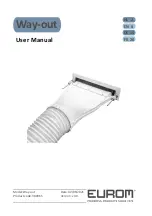
5
English
2.
MAIN COMPONENTS
For main components and function of the main components, refer to
the Engineering Data Book.
3.
SELECTION OF LOCATION
This unit, both indoor and outdoor, is suitable for installation in a com-
mercial and light industrial environment. If installed as a household
appliance it could cause electromagnetic interference.
The VRV
II
OUTDOOR units should be installed in a location that
meets the following requirements:
1.
The foundation is strong enough to support the weight of the unit
and the floor is flat to prevent vibration and noise generation.
2.
The space around the unit is adequate for servicing and the min-
imum space for air inlet and air outlet is available.
(refer to figure 1 and choose one of both possibilities)
(Refer to figure 1)
1.
Front side
2.
No limit to wall height
3.
Suction side
3.
There is no danger of fire due to leakage of inflammable gas.
4.
Ensure that water cannot cause any damage to the location in
case it drips out the unit (e.g. in case of a blocked drain pipe).
5.
The piping length between the outdoor unit and the indoor unit may
not exceed the allowable piping length. (see “Example of connection”)
6.
Select the location of the unit in such a way that neither the dis-
charged air nor the sound generated by the unit disturb anyone.
7.
Make sure that the air inlet and outlet of the unit are not positioned
towards the main wind direction. Frontal wind will disturb the oper-
ation of the unit. If necessary, use a windscreen to block the wind.
Caution
1.
An inverter air conditioner may cause electronic noise gener-
ated from AM broadcasting. Examine where to install the main
air conditioner and electric wires, keeping proper distances
away from stereo equipment, personal computers, etc.
(Refer to figure 2)
1.
indoor unit
2.
Branch switch, overcurrent breaker
3.
remote controller
4.
cool/heat selector
5.
personal computer or radio
If the electric wave of AM broadcasting is particularly weak,
keep distances of 3m or more and use conduit tubes for
power and transmission lines.
2.
In heavy snowfall areas, select an installation site where snow
will not affect operation of the unit.
3.
The refrigerant R22 itself is nontoxic, nonflammable and is
safe. If the refrigerant should leak however, its concentration
may exceed the allowable limit depending on room size. Due to
this it could be necessary to take measures against leakage.
Refer to the chapter “Caution for refrigerant leaks”.
4.
Do not install in the following locations.
•
Locations such as kitchens which contain a lot of mineral oil or
steam in the atmosphere or where oil may splatter on the unit.
Resin parts may deteriorate, causing the unit to fall or leak.
•
Locations where sulfurous acids and other corrosive gases
may be present in the atmosphere.
Copper piping and soldered joints may corrode, causing
refrigerant to leak.
•
Locations where equipment that produces electromagnetic
waves is found.
The electromagnetic waves may cause the control system to
malfunction, preventing normal operation.
•
Locations where flammable gases may leak, where thinner,
gasoline, and other volatile substances are handled, or
where carbon dust and other incendiary substances are
found in the atmosphere.
Leaked gas may accumulate around the unit, causing an
explosion.
4.
INSPECTING AND HANDLING THE UNIT
At delivery, the package should be checked and any damage should
be reported immediately to the carrier claims agent.
When handling the unit, take into account the following:
1.
Fragile, handle the unit with care.
Keep the unit upright in order to avoid compressor damage.
2.
Choose the path along which the unit is to be brought in ahead of
time.
3.
If a forklift it to be used, pass the forklift arms through the large
openings on the bottom of the unit.
4.
Lift the unit preferably with a crane and 2 belts of at least 8m long.
5.
When lifting the unit with a crane, always use protectors to prevent
belt damage and pay attention to the position of the unit’s centre
of gravity.
6.
After installation, remove the transport clasps attached to the
large openings.
7.
Bring the unit as close to its final installation position in its original
package to prevent damage during transport.
(Refer to figure 3)
1.
Packaging material
2.
Forklift
3.
Opening (Large)
4.
Belt sling
5.
Opening (Small) (40×30)
6.
Wear plate
7.
Removal of shipping brackets
8.
Shipping bracket (Remove the screws.)
01_3P114261-9L-EN.fm Page 5 Thursday, August 28, 2003 3:33 PM








































